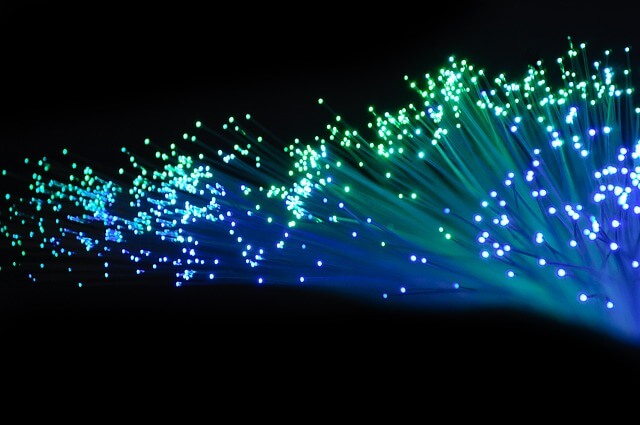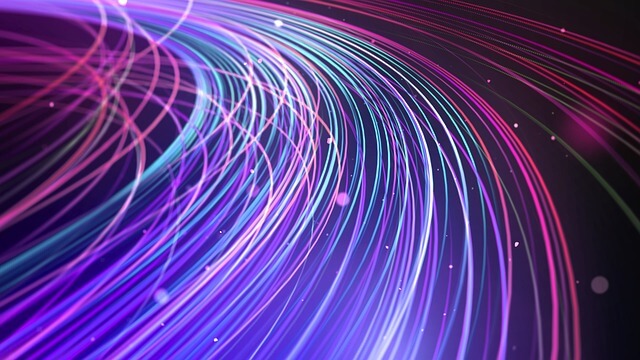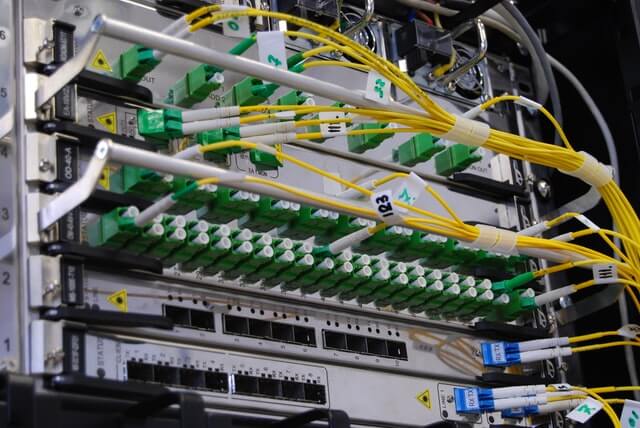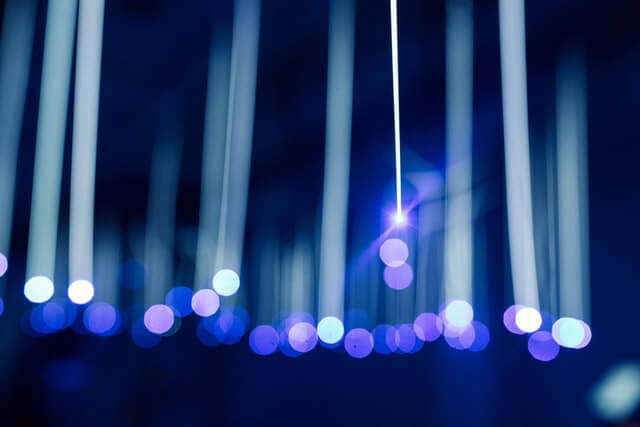
Fiber optics is one of the popular ways of sending information via thin fibers. It has become a dominant alternative for copper cables as it provides better speed, support, and better image quality. Its thin and light wires can conduct voice, data, and images.
Fiber optics are made of either plastic and glass. These optics are very thin, almost the size of human hair. These optics are used in bundles to form a fiber cable. Fiber optics can transmit information through these optics in the form of light, and they are quite popularly used in computers and telephone cables. Moreover, doctors too use them to see the inside of the human body.
In this system, a transmitter turns information into lights, and then the light is sent through the optical fibers. The inner part of the fiber is called the core, which is surrounded by cladding. The cladding helps the light to move through the cable easily and helps cover long distances in a very short time.
- Name: Fiber optics
- Invented in: 1950
- Dimension: 0.125 mm or 125 micometers (0.005 inches)
39 Fiber Optics Facts for kids
- Fibers were not used for telecommunication until 1790
- The optical telephone system was invented by Alexander Graham Bell around the 1880s. It led to the formation of fiber cabling in the 1950s.
- After fiber optics was invented in the 1950s, it became widely used in the medical field. Fiber optics helped in the illumination and imaging components of endoscopes which helped doctors to see the human body from inside.
- A decade later, an experienced fiber optic technician found out that the same fiber optics can also be used in the telecommunication system.
- George Hackham and Charles Kao, two electrical engineers, working in England, proposed the idea of using fiber optics for telecommunication.
- Silica glass fibers were produced in the following two decades to infrared light signals, which could travel through them for sixty miles without having to be enhanced by repeaters.
- In the year 2009, Charles Kao was awarded the Nobel prize for his contribution to the field of physics.
- Gradually it was invented that plastic fibers are cheaper than glass fibers and also are more flexible.
- Apart from communication and the medical field, fiber optics are also used by engineers to throw light on parts of machines where normal light can’t easily reach.
- Fiber optics are used in areas that are hard to reach, like under the sea or deep underground spots.
- Fiber optics come with three primary parts, which are- the cladding, core, and outer coating.
- Depending on the required transmission range, the core is made of either glass or plastic material.
- Light is only transmitted through the core.
- The light passes through the cable in the same way as the rays of a torch pass through a narrow shaft.
- Using fiber optics requires less energy. This is beneficial for the environment because less energy means less greenhouse gas emissions.
- Fiber optics cables require less energy to send flashlights compared to the energy required in copper cables to send flashlights.
- Copper and such other materials come with their own limitations. If they come in contact with tin or something like, they can break easily.
- Fiber optics come with a great bandwidth, and it is one of its great advantages. Due to the large wavelength, fiber optics can transmit signals with more information.
- Fiber optics is very light and cheap to work with, and it can be made quite small and thin.
- Fiber optic cables are made of glass. However, they are not fragile.
- Fiber optics cables can take almost 200 pounds of pulling tension. This is quite a lot compared to ethernet cables. Ethernet cables can endure only up to 25 pounds of pulling.
- The center conducting cylinder of these fiber optics has a diameter as small as 10 micrometers.
- Other glass fibers come with a diameter of 0.125 mm or 125 micrometers (0.005 inches)
- Fiber optics can work without any connection for grounding. Both the transmitter and the receiver are separated from each other, due to which there is no issue of ground loop.
- Fiber optics are electromagnetic interference-resistant, and they emit no radiation.
- Fiber optics can also be used as illumination for decorative purposes or as exhibiting signs.
- Fiber optics transmit light, not electricity, due to which any weather changes can not affect it.
- As fiber optics don’t transmit electricity hence, there is no risk for you at all.
- Fiber optics are a more sustainable option than traditional cables. It is more environmentally sustainable and energetically efficient.
- Fiber optics do not radiate electromagnetic energy, which is why it is quite safe, and any transferred information can not be inferred with.
- Fiber optics come with an endless lifecycle as against the electromagnetic cables. Moreover, fiber optics can be upgraded without having to change the cable.
- Two of the richest elements found on earth, silica, and oxygen are used in the composition of fiber optics technology.
- Long Beach, California, was the first city in the USA to use fiber optics to send telephone traffic in 1977.
- By 2011, 2 million fiber optics cables were installed in the houses of the US.
- By 2012, 3 million homes in North America had fiber to the home service.
- All new houses in China are to have fiber optics.
- Sandia National Laboratories in Albuquerque has the biggest private-owned fiber optics network in the world. It connects 13,000 computer networks and 265 buildings.
- The first fiber optics television was made in the year 1980 during the winter Olympics.
- Sending and receiving signals through fiber optics is as fast as 99.7% of light.
- Jaipur is the biggest emerald cutting center in the world. Columbia increased the production of emeralds up to 80% from 2001 to 2010.
- The most crucial factor for pricing an emerald is the color.
- The second-largest producer of emeralds in the world is Zambia. It contributes 21% of the total emerald production in the world.
- In Pompei, Italy, a beautiful emerald jewelry piece was found under the ash from Mt. Vesuvius.
Conclusion
Fiber optics is one of the fastest mediums of transmitting light and receiving and sending signals. It also requires less energy hence safe for the environment and also sustainable.
Fiber active is also a very cost-effective option as these fiber optic wires last for decades to come. Due to its durability and cheapness, fiber optics has become a widely used alternative for copper or other material wires.
Fiber Optics Pictures



Additional Resources about Emeralds
- Fiber Optics info – A solid info article on fiber optics
- Britannica – Learn more about fiber optics
- What are fiber optics – Learn fiber optics like you never knew before
